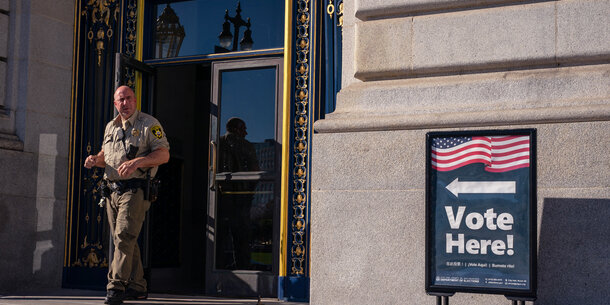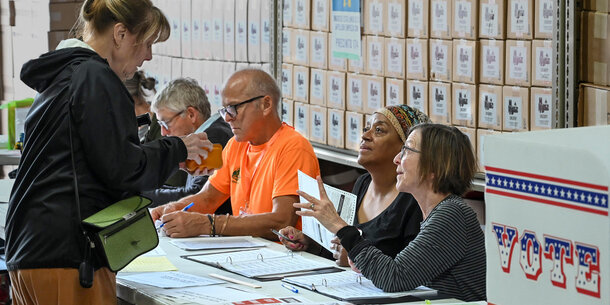Partisan poll watchers have long played an important part in observing elections. Though their duties, constraints, and powers vary from state to state, their role is meant to provide more transparency to the voting and vote-counting process. But after a multiyear misinformation campaign seeking to undercut confidence in the 2020 election results, some poll watchers in 2022 may be primed to search for material to support false claims of widespread fraud, allege misconduct where none exists, or spread election misinformation through misleading “eyewitness” testimony and noncredible anecdotes.
Adding to the risk, some states have enacted laws since 2020 that empower partisan poll watchers and offer more opportunities for misinformation to emerge. And, as seen in 2020, some national groups, officials, and activists appear to be preparing to collect testimony from partisan watchers and challengers to contest election results.
National groups and grassroots organizations that have promoted conspiracy theories about the election have also helped mobilize thousands of individuals to fill key election positions and serve as poll watchers this year. Some areas have seen spikes in poll watcher numbers in early voting or surges in interest in watcher roles, and several contests after 2020 — including primary and off-year elections — have drawn allegations of disruptive behavior by some watchers. Both parties traditionally field poll watchers, but the Republican National Committee has this year conducted an unprecedented push to recruit watchers in battleground states.
The possible consequences of empowering rogue partisan observers were made clear in 2020. Unreliable testimony from some poll watchers and challengers was cited in numerous failed lawsuits filed by Trump’s campaign and his allies to try to overturn the election results. For instance, in a Michigan case filed to try to stop ballot counting, a poll watcher claimed that a different, unnamed poll watcher told her that county poll workers instructed the unnamed poll watcher to falsify ballots’ date of receival. A judge ultimately dismissed the case, panning the claims as shockingly insubstantial: “I heard someone else say something . . . Tell me how that is not hearsay. Come on now!”
Poll watchers and challengers’ claims in lawsuits have distorted state or local vote procedures. In another Michigan case, for example, plaintiffs tried unsuccessfully to block certification of election results after a Detroit poll challenger falsely claimed that election workers improperly stopped Republican challengers from observing the vote count. But as a former state director of elections and another poll challenger clarified by affidavit, Detroit imposed limits on poll challengers allowed in ballot-counting rooms due to the Covid-19 pandemic, and both Democratic and Republican challengers were prevented from reentering the vote-counting hall only when that threshold was met.
The misinformation risk is particularly great in several states that have given poll watchers greater access or autonomy since 2020. For instance, a new law in Florida mandates that officials allow partisan poll watchers “reasonable access” to review or inspect ballot materials, including mail ballot envelopes and signatures. At the same time, the law does not impose any limit on the number of ballots that watchers can challenge. Because of the law, election officials in Central Florida are already seeing more poll watchers and numerous challenges to voter eligibility during early voting for the midterms.
In some instances, new state laws result in unfamiliar voting conditions that can in turn seed misinformation. In Texas, for example, a new law makes it a crime for poll workers to knowingly obstruct poll watchers’ views or “distance” watchers so that their observation is “not reasonably effective.” The vaguely worded prohibitions and harsh penalties likely contributed to pervasive poll staff shortages in the state’s primary in March. The confusion caused by understaffed poll sites fueled conspiracy theories on social media.
The possibility that some poll watchers will conduct searches for “evidence” to prop up false conspiracy theories raises concerns that there could be an increased risk of voter intimidation from watchers. This year’s poll watcher recruitment drives have occurred in the wake of the expiration in 2018 of a long-standing court order that had previously curtailed efforts by the Republican National Committee to recruit observers. The restrictions were imposed by a 1982 consent decree that resulted from allegations that the committee had improperly targeted Black voters. But voter intimidation is always against the law, and voters have resources to draw on to feel safe when voting.
If hassled by a poll watcher, voters can alert a poll worker or local election official or call 866-OUR-VOTE. Local election officials can continue to work with state officials, the media, and civic groups to put out corrective information to debunk any false claims. And news organizations can give proper context to unreliable testimony from some partisan watchers seeking to undermine confidence in election results. Our elections are safe and secure, and now they require vigilance against attempts to cast doubt on their integrity.



